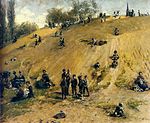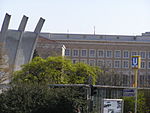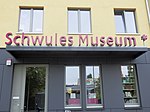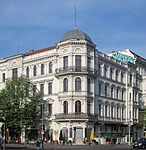Friedrich-von-Raumer-Bibliothek

The Friedrich-von-Raumer-Bibliothek (Friedrich von Raumer Library) is a public library in Berlin. It was founded in 1850 and is located in Berlin's Kreuzberg locality on Dudenstraße. After several moves the library found its current location in 1955 in a block of flats of the services trade union Ver.Di by Franz Hoffmann and Max Taut. The library is located in the rotunda, westerly protruding from the block of flats, and in the ground floor of that block. The Raumer Library is a so-called neighbourhood library (Stadtteilbibliothek) within the Stadtbibliothek Friedrichshain-Kreuzberg (city library of the Friedrichshain-Kreuzberg borough), and as such part of the Verbund der Öffentlichen Bibliotheken Berlins (VÖBB), the network of public libraries owned by the city-state.
Excerpt from the Wikipedia article Friedrich-von-Raumer-Bibliothek (License: CC BY-SA 3.0, Authors, Images).Friedrich-von-Raumer-Bibliothek
Dudenstraße, Berlin Kreuzberg
Geographical coordinates (GPS) Address Nearby Places Show on map
Geographical coordinates (GPS)
| Latitude | Longitude |
|---|---|
| N 52.485195 ° | E 13.38296 ° |
Address
Dudenstraße 20
10965 Berlin, Kreuzberg
Germany
Open on Google Maps











